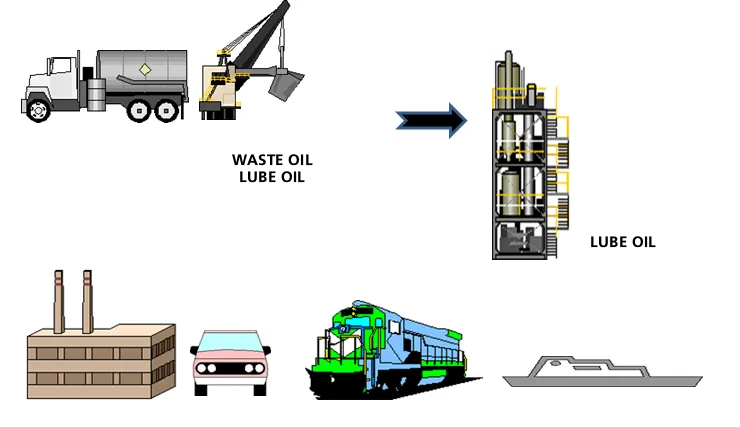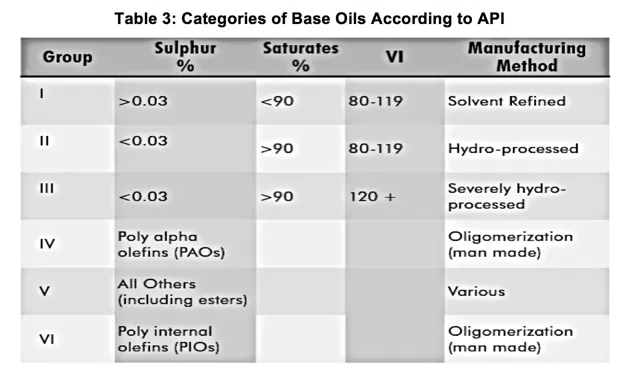
How are lubricants produced
A lubricant consists of 70-100% base lubricants and up to 30% chemical compounds known as additives, which are fully mixed.

The natural or crude oil obtained from the oil wells is a mixture of hydrocarbons, gases and other unwanted components (Table 1).

The above components of crude oil can be integrated into more general categories. Some of them impart desirable properties to lubricants while some have harmful properties and effects. Hydrocarbons are called the mainstream organic components of “crude” oil, consisting solely of carbon and hydrogen. They are categorized as follows (Figure 1):
§ Alkanes or paraffins, with saturated linear or branched carbon chains in single bonds,
§ Alkenes or olefins, with saturated (or unsaturated) molecules in double bonds of carbon,
§ Ali-cyclic hydrocarbons or naphthenes, saturated cyclic structures consisting of five or six carbon atoms in single bonds between them,
Aromatic hydrocarbons, circular structures with double bonds which rely heavily on the sixfold benzene ring (C6Η6).

Having as a criterion the basic content of crude oil in alkanes/paraffins (crystalline texture hydrocarbons, solid at normal atmospheric temperature with a colour close to white) and asphalt (crystalline or semi-solid compounds of ‑black or black-brown colour consisting of polycyclic aromatic hydrocarbons), we distinguish three main categories of crudes:
§ Oils of paraffinic base
They have low specific gravity, contain paraffin, little or no asphalt and give away a great proportion of mineral oils. In this category we have the oils of N. Pennsylvania and the North Sea.
§ Oils of asphaltic and naphthenic base
They have high specific gravity, contain asphalt, little or no paraffin and give away a small proportion of mineral oils. The oils of Nigeria, California, Mexico, the Mexican Gulf and Venezuela belong to this category.
§ Oils of mixed base
They contain asphalt and paraffin and the overwhelming majority (90%) of oils (e.g. oils of the Middle East and East Texas, USA) belongs to this category.
It is worth noting that the “crude” oil coming from various oil wells differs in texture, not only from place to place, but even in the same area. In oil refineries, the “crude” oil is subjected to fractional distillation and a number of other processes, which result in different types of fuels, base oils, paraffin, asphalt and even some secondary products (Figure 2).

Concerning the production of base oils, their production process consists of the following steps:
§ Distillation: the process of removing the components at a very low and very high boiling point, leaving the distillate in the boiling range of the lubricant.
§ Removal of aromatics: It leaves the lubricating oil behind with a high proportion of saturated hydrocarbons, and improves its viscosity index and stability.
§ Dewaxing: It removes candles and controls the low temperature properties of the lubricant.
§ Finishing: It removes the polar components, and improves the color and stability of the base oil.
The return on the base oil from the distillation column of the refinery depends on the proportion of desirable components in the range of the lubricant’s boiling points. Distillates of base oils derived from different oils have very different properties (Table 2).

Although the refining and processing techniques have been developed technologically in order to produce base mineral oils with very good properties, those produced cannot meet the requirements of today’s applications. For this reason, to the base mineral oils they add chemical additives or improvers, which enhance their physicochemical characteristics and properties while giving the final product properties and characteristics required for every application. This work is done in the mixing units, which can be within or outside the refineries.
The waste lubricant, through the contamination undergone during use, has become unsuitable for lubrication due to the presence of impurities and other products (e.g. other lubricants of mineral and/or synthetic base, water, fuel, asphalt products, etc.) or due to the loss of its original properties. Re-refining separates water, oil and asphalt products and through distillation it restores the lubricating oil (distillate) as in the refining process.

The hydrotreating unit treats the lubricant (distillate) in the presence of selected catalysts in order to clean undesirable chemical compounds that make the lubricant unsuitable for use as a base. The result is the conversion of olefins (alkenes) and aromatic components in high quality added value saturated (paraffinic) and/or naphthenic (cyclic) bases, which are much less toxic and more “neutral”. More specifically, they show:
§ Perfect colour
§ High viscosity index
§ Low volatility (variability)/high stability
§ Low content in sulphur (an oxidizing and corrosive “material”), on the one hand to improve the quality and stability of the bases, on the other hand for long-term protection, for example, of diesel particulate filters (or DPF) and diesel engines.
§ Very low acidity (TAN), which means that the produced base oil (given the removal of its aromatic components, see below) exhibits high oxidative stability (and thus not easily oxidized).
§ Low content in polycyclic aromatic hydrocarbons (PAH) which degrade the quality of the base oil, as their acidity starts a chain reaction that dramatically reduces its useful life.
§ Low pour point for suitability of use in formulas of final lubricant products which are expected to yield at low temperatures (combined with the special additives of further depressant of the pour point).
The produced base lubricant is blended with chemical additives to produce lubricants for all uses, it is used, and at the end of its lifecycle it is collected and re-treated by the refinery and thus the lifecycle of the lubricant starts again…

Synthetic lubricants first appeared in the early 1930s, as synthetic hydrocarbon and ester technologies were developed at the same time in Germany and the USA. The increasing demand of lubricants to perform in ever expanding temperature function ranges (mainly driven by the developments in the engines of the military aircrafts) marked the continuing development of synthetic lubricant technology.
Today, there are synthetic lubricants and they are used in virtually all fields and applications that require lubrication: automotive, shipping, industry and certainly in aviation and aerospace. A plurality of base oils has been investigated for their use as potential synthetic base oils of final lubricants, out of which the most prevalent ones are:
Poly-alpha-olefins (English abbreviation: PAO) are produced with a process commonly termed “synthesis”. They are completely synthetic compounds derived from the polymerization of an alpha-olefin. It is a particular type of olefin (organic) used in the production of synthetic lubricants. They offer a wide range of lubricating properties because they have very stable structures and highly uniform molecular chains.
Esters are 100% synthetic chemical compounds resulting from the reaction of an acid with an alcohol or a phenol. Many esters with different chemical compositions each, because of their excellent lubricity, are used for various reasons, either as additives or as base oils for the production of final lubricants. Due to their high cost, they are used in a small proportion in the formula in order to improve the stability of the final product.
API (American Petroleum Institute) in the USA has categorized the base oils as for their origins (mineral or synthetic) and their method/process of production, the range of their viscosity index and the percentage of saturated hydrocarbons (Table 3).
